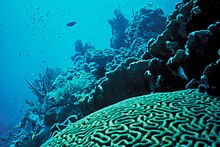
Article Evaluation: Article to be improved throughout the semester
Coral Reef Protection Article
- Some of the links were old or not working
- Take out information that is referenced by invalid links
- More background information is needed
- There is a view-point in the article. It is assuming about over fishing, there need to be statistics behind the claim.
- Information is not referenced when it needs to be
Coral Reef Protection: New references for page
[1] Coral Reef Ecosystem Article: Gives background information of corals
[2] Coral Reef Services Article: Information to update Coral Reef Protection Article'
Coral reef protection is the process of modifying human activities to avoid damage to healthy coral reefs and to help damaged reefs recover. The key strategies used in reef protection include defining measurable goals and introducing active management and community involvement to reduce stressors that damage reef health. One management technique is to create Marine Protected Areas (MPAs) that directly limit human activities such as fishing.[1] Often, Marine Protected Areas have a primary goal of conserving biodiversity or enhancing the sustainability of exploited fish stocks.[2]
It takes approximately 10 thousand years for coral polyps to form a reef, and between 100,000 and 30 million years for a fully mature reef to form.[3]
Coral reefs
editCoral reefs are among the most productive and biologically diverse ecosystems on Earth.[4] Differences in exposure to wave patterns create a variety of habitat types.[5] The coral need a mutualistic symbiotic relationship with zooxanthellae algae in order to build a reef. The single celled algae derive their nutrients by using photosynthesis, and the coral provide shelter to the algae in return for some of the nutrients.[3] Zooxanthellae populations can die with changing environmental conditions, causing the coral to lose color, known as coral bleaching.[6]
Ecosystem services[edit]
editCorals supply large numbers of people with goods and services such as seafood, recreational possibilities, coastal protection as well as aesthetic and cultural benefits. Reefs generate a variety of seafood products such as fish, mussels, crustaceans, sea cucumbers and seaweeds. The value coral reefs have contribute 1.8% ($375 billion USD) to ecosystem services[7]. As coral reefs constitute only 0.2% of the world's marine ecosystems. [7]
Biodiversity[edit]
editThe coral reef ecosystem provides habitat to over 9 million species covering approximately one fourth of marine life. Its three dimensional structure provides hiding places for fish, shrimp and clams. Coral itself is consumed by species such as parrotfish. It provides a hunting ground for predators.
***Need to put in references and add more information.
Medicine[edit]
editCoral reefs houses plants and animals that produce chemical compounds that have found use in human medicines. As early as the 14th century, the medicinal properties of coral reef dwelling species were utilized. Antiviral extracts and tonics continue to be studied and toxic compounds such as neurotoxins discovered in coral reefs have proven beneficial as painkillers. The limestone skeleton of coral has been tested and used for human bone grafts, due to its porous nature and has a lower rate of rejection than artificial bone graft materials.
General Interests[edit]
editThere are three main categories of interest the public should have for the preservation of coral reefs: the preservation of natural beauty and value, the promotion of the local economy, and long-term scientific goals.
Over one-third of marine species call coral reefs their home. This creates a beautiful underwater experience for snorkelers and divers. This great genetic biodiversity has a lot of potential for industries like pharmaceutics, biochemistry, and cosmetics. This biodiversity also boosts the economy through an increase in marine tourism and commercial fisheries. Long-term, coral reefs have been recognized as large contributors to the absorption of carbon dioxide emissions which has been an important part of the mitigation of climate change.
This is a user sandbox of LHauptman. You can use it for testing or practicing edits. This is not the sandbox where you should draft your assigned article for a dashboard.wikiedu.org course. To find the right sandbox for your assignment, visit your Dashboard course page and follow the Sandbox Draft link for your assigned article in the My Articles section. |
- ^ "Coral Reefs". National Fish and Wildlife Foundation.
- ^ Wenger, Amelia S.; Williamson, David H.; da Silva, Eduardo T.; Ceccarelli, Daniela M.; Browne, Nicola K.; Petus, Caroline; Devlin, Michelle J. (2016-02-01). "Effects of reduced water quality on coral reefs in and out of no-take marine reserves". Conservation Biology. 30 (1): 142–153. doi:10.1111/cobi.12576. ISSN 1523-1739.
- ^ a b "Stanford : Types of Reefs".
- ^ Moberg, Fredrik; Folke, Carl. "Ecological goods and services of coral reef ecosystems". Ecological Economics. 29 (2): 215–233. doi:10.1016/s0921-8009(99)00009-9.
- ^ "Stanford : Reef Structure".
- ^ "Stanford : Reef Structure".
- ^ a b Souter, David W; Lindén, Olof. "The health and future of coral reef systems". Ocean & Coastal Management. 43 (8–9): 657–688. doi:10.1016/s0964-5691(00)00053-3.